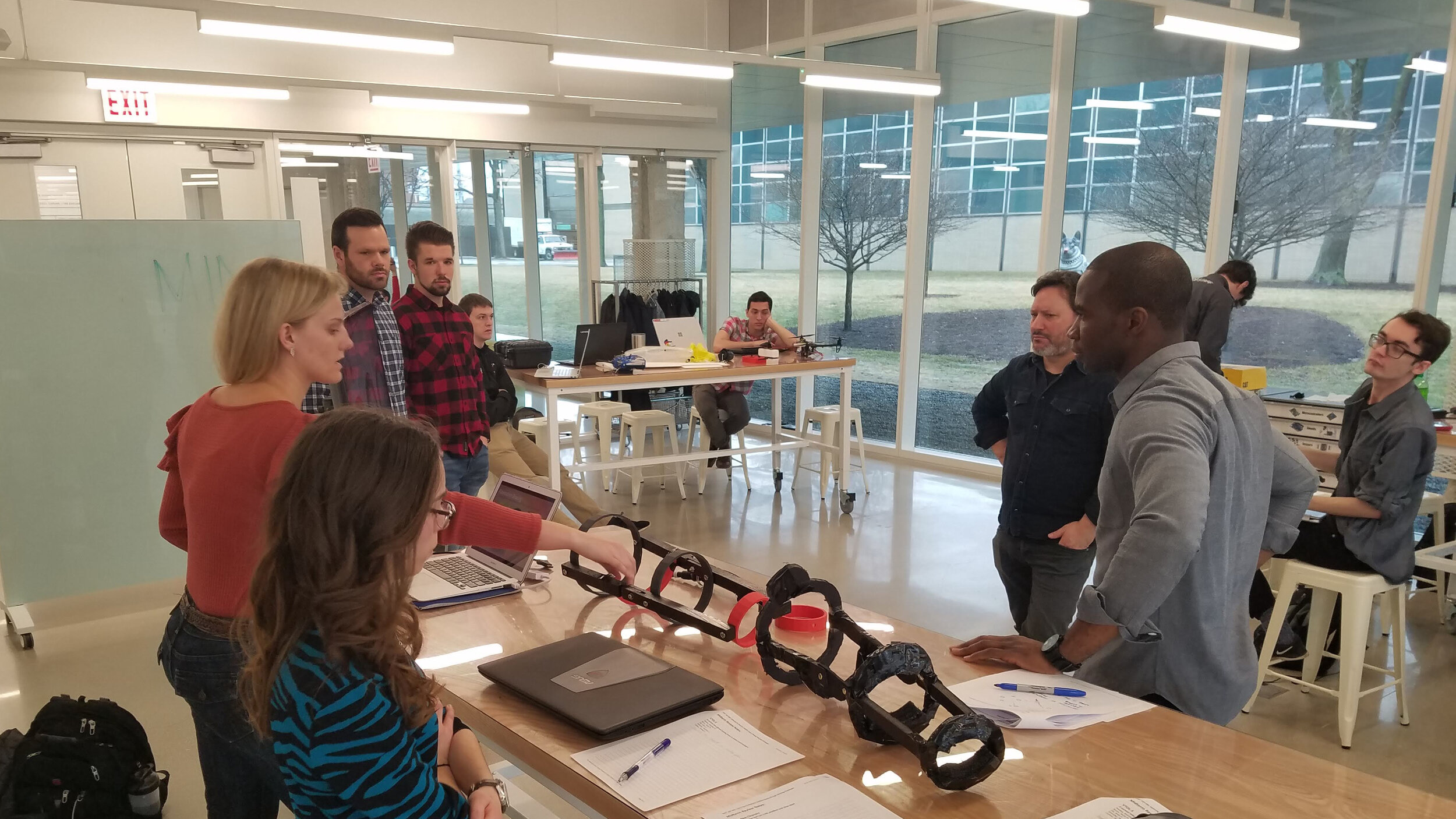
Illinois Institute of Technology
Interprofessional Projects Program
Thomas J McLeish,
Students presenting work and gathering peer feedback.
Since 1995 Illinois Tech’s IPRO Program has provided the alternative to a traditional undergraduate education. Our signature IPRO Program remains one of just a few programs of its kind in the country. IPRO joins students from various majors to work together to solve real-world problems, often on behalf of sponsor companies and nonprofits. A required academic program, IPRO teaches leadership, creativity, teamwork, design thinking, and project management—uniquely preparing students to succeed in a professional work environment.
The robotics IPRO experience emphasized the making of robotics prototypes through an agile process involving small interdisciplinary teams within the class. The prototypes were built up through student discovery of opportunities, founded in their passion, interest and creativity. The multiple IPRO teams in the class were stimulated and informed by interdisciplinary discussions at the convergence of Engineering Methodologies, Design Thinking, and Ethics.
Vertical Takeoff and Landing
It is difficult to get small payloads like medicine [2Kg] to moderately remote areas of the world quickly and at low cost.
Jake Bruns, Brinden Carlson, Brendan Howley, Brett Ott, Matthew Schindler
Omnidirectional Platform
While able to dynamically traverse a wide variety of terrain, a hovercraft as a platform would be able to serve more use cases if it were more maneuverable. Team Omnidirectional prototyped and tested a hovercraft platform more maneuverable than the standard single directional fan platform. The team worked through iterations of the omnidirectional platform as hovercraft, iterations of horizontal movement actuation with fans, iterations of fan control algorithms, iterations of smartphone software horizontal motion control.
Student Team
Ramir Aguilos, Kislay Bhagat, Robert Hyc, Jiaxi Liu, Yen Nguyen, Scott Partacz,
Uzair Riaz, Manuel Sida, Jiateng Sun, Paolo Tamayo
Augmented Perception for Visual Impaired
Visually impaired individuals around the world need a safe and easy way to navigate their surroundings to give them freedom and independence within a visually able community. Prototypes built explored and tested a safe and easy way for blind individuals around the world to navigate their surroundings giving them a sense of freedom and independence within a visually able community.
Student Team
Sam Bjorklund, Madison Davis, Ismaeel Ghouse, Nate Mark, Noah Reardon, Dominic Zerillo
Prototype 1
A virtual white cane allows visually impaired individuals to navigate their environments without carrying a cane that is prone to damage and also interfering with the movement of bystanders
The virtual cane incorporates a proximity sensor and haptic feedback device into a wearable device such as a watch/bracelet. This allows individuals to get a feel for objects in their vicinity similar to how they would with a white cane, but without actually carrying a cane. The vibration intensity/speed would vary to indicate the distance of the obstacles.
One test that will need to be run is to determine the ideal buzzing frequency for various distances, as well as how quickly the frequency should increase as obstacles approach. Another test will be to determine how effectively the device can be used to navigate a room.
Prototype 2
A new design for the tip of white canes to prevent them from getting caught in cracks and breaking. A common problem with white canes is that as they are swept along in front of the user, and it is easy for them to get stuck in sidewalk cracks, leading to the user to walk into the cane, possibly resulting in injury to the user and breakage of the cane. This prototype is a new design for the tip of white canes to prevent them from getting caught in cracks and breaking. Testing will be done to ensure that the white cane tip is not getting caught in sidewalk cracks and other obstacles. Using the white cane outside in various terrains with and without the removable tip is how we will measure the effectiveness of the tip.
The materials needed for this prototype are foam board, duct tape, styrofoam ball, plastic ribs.
A Robotic Arm Brace for Physical Therapy
Patients undergoing physical therapy are unable to return to work as they try to avoid overstressing muscles while they are healing. Here, we explore a brace to be used by patients during arm muscle rehabilitation that enables a return to work through an initial prototype.
Student Team
Tim Clemmons, Madison Davis, Miriam Miller, Mateusz Rychtarczyk
Architecture on the Go
In a world of limited space, urban inhabitants need their limited space to fulfill many life needs. Real-time user responsive architectural system maximizing density while maintaining comfort in an ever-urbanizing world. Prototypes were built to explore and test a demonstration of architectural component human touchpoints in a scale model, a demonstration of a human-computer interface via tags and a smartphone app, a mock-up of a full-scale module, a demo of architectural structural system reconfiguration.
Student Team
James T. Arnold, Ludin J. Castillo, Joshua H. Mac-Williams, Jordan Mynes
Augmenting Physical Environments for the Visually Impaired
Visually impaired people have trouble navigating in unfamiliar environments. Solutions include embedding sensors into physical placards, test revealed this proved cumbersome to install and difficult to integrate into a single housing.
A standalone solution proved more versatile. The team transitioned to virtual prototyping of a more user-friendly and discrete system.
Student Team
Ryan Arendt, Michael Douros, Tanner Dyer, Michael Hu, Michael Kuehni, Bright Lesi




